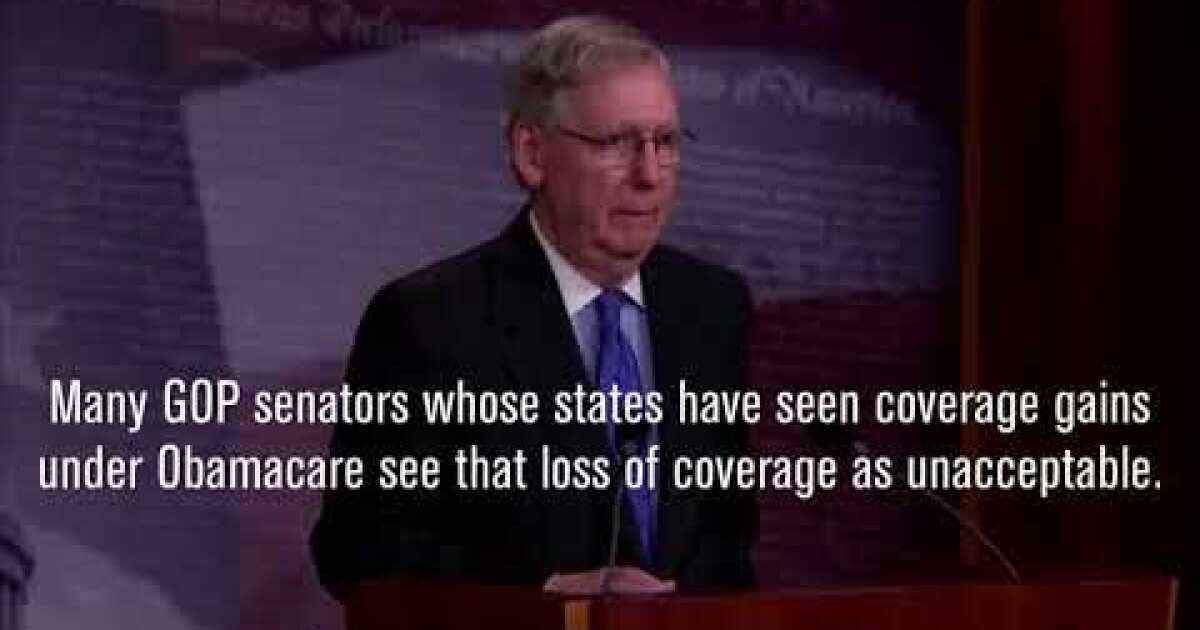GOP senators can cut Obamacare taxes or preserve coverage for millions — but probably not both
Reporting from Washington — As they wrestle with how to replace the Affordable Care Act, Senate Republicans face a critical choice between cutting taxes or preserving health coverage for millions of Americans, two competing demands that may yet derail the GOP push to roll back the 2010 healthcare law.
House Republicans, who passed their own Obamacare repeal measure this month, skirted the dilemma by cutting both taxes and coverage.
For the record:
5:48 a.m. July 1, 2019An earlier version of this story suggested incorrectly that Senate Republicans might be able to restore some health assistance to low- and moderate-income Americans without scaling back tax cuts. But budget rules passed by GOP lawmakers earlier this year require that any new spending in the bill be offset with other cuts or new revenues.
Their bill — embraced by President Trump — slashed hundreds of billions of dollars in taxes, a key goal of GOP leaders and the White House as they seek to set the stage for a larger tax overhaul later this year.
At the same time, the House legislation cut more than $1 trillion in healthcare assistance to low- and moderate-income Americans, a retrenchment the nonpartisan Congressional Budget Office estimates would nearly double the ranks of the uninsured over the next decade to more than 50 million.
In the Senate, coverage losses on that scale are worrisome to many rank-and-file Republicans whose states have seen major coverage gains under Obamacare. That makes the preservation of benefits one of the biggest challenges confronting Senate Majority Leader Mitch McConnell (R-Ky.) and other GOP leaders.
“Coverage matters,” Sen. Bill Cassidy (R-La.) said last week on MSNBC’s “Morning Joe” program, noting the importance of preserving Medicaid spending in the current law. “To someone [who] is lower-income, you’re going to need those dollars to cover that person.”
Yet moderating cuts to Medicaid and other government health programs without driving up budget deficits could force Republican senators to also dial back the tax cuts that many in the GOP want.
“It’s not that complicated. … If you want to use money for tax reform, you can’t have it for health coverage,” said Gail Wilensky, a veteran Republican health policy expert who ran the Medicare and Medicaid programs under President George H.W. Bush. “You can’t do both.”
McConnell convened a group of GOP senators — quickly panned for including only white men — to develop Obamacare replacement legislation, though the panel largely excluded Republican lawmakers who are most concerned about coverage, including Cassidy. McConnell has since said that all Senate Republicans would be involved in developing an Obamacare replacement.
The trade-off between cutting taxes and preserving Americans’ health protections reflects, in part, the legislative procedure that congressional Republicans have chosen to repeal the Affordable Care Act.
That process, known as budget reconciliation, allows Senate Republicans to pass their Obamacare repeal with a simple majority, rather than the 60-vote super-majority that is usually required to pass controversial legislation. (Republicans have only a 52-48 majority in the Senate.)
But to qualify for budget reconciliation under Senate rules, the bill must reduce the federal deficit over the next decade.
Tax cuts alone typically do the opposite, driving up budget deficits.
The tax cuts in the House Republican healthcare bill total more than $600 billion over the next decade, according to independent analyses by the Congressional Budget Office and the congressional Joint Committee on Taxation.
They include most of the major taxes enacted in the 2010 health law to fund the law’s program for extending health insurance to more than 20 million previously uninsured Americans.
On the chopping block are taxes on medical device makers and health insurance plans, which together account for about $165 billion in tax cuts over the next decade.
Couples making more than $250,000 a year (and single taxpayers making more than $200,000) would see two tax cuts, including one on investment income, that the budget office estimated would cost the federal government nearly $300 billion over the next decade. (That estimate may be revised down as House Republicans delayed one of the tax cuts in the final version of their bill.)
Also eliminated would be a host of limits on tax-free spending accounts that many Americans use for medical expenses. Republicans argue these taxes are unnecessary and even undermine efforts to control healthcare costs.
“It’s bad for economic growth,” House Speaker Paul D. Ryan (R-Wis.) told Fox News during the House debate.
The tax on health plans, for example, is widely seen as contributing to higher premiums, as insurers customarily pass the costs along to consumers.
But eliminating so many taxes isn’t cheap.
So the Republican healthcare bill — known as the American Health Care Act — slashes hundreds of billions of dollars in federal healthcare spending, including an estimated $880 billion in federal money for Medicaid, the state-run government health plan for the poor that currently covers more than 70 million Americans at any one time.
That would in effect cut federal Medicaid spending by more than a quarter over the next decade, an unprecedented reduction that independent analyses suggest would force states to sharply limit coverage for poor patients.
The House bill would also reduce insurance subsidies now available to low- and moderate-income Americans who get health plans through Obamacare marketplaces such as HealthCare.gov.
The reduction in federal aid would, in turn, dramatically increase the number of uninsured Americans. Overall, the Congressional Budget Office has estimated that 24 million fewer people would have health coverage by 2026 under the original version of the House bill.
By contrast, the wealthiest Americans stand to get a large tax break. By 2023, families making more than $1 million would see their taxes decrease by an average of more than $50,000, an analysis by the independent Urban-Brookings Tax Policy Center suggests.
That means that in a country of more than 300 million people, nearly half of all the tax breaks in the House healthcare bill would go to only about 780,000 households.
The combination of tax breaks for wealthy Americans and historic reductions in assistance to low-income patients has fueled widespread criticism of the House GOP healthcare legislation, particularly on the left.
“The math is pretty clear,” said Edwin Park, vice president for health policy at the liberal Center on Budget and Policy Priorities. “They are sharply cutting Medicaid and insurance subsidies to pay for tax cuts.”
Whether GOP senators will be able to moderate the reductions in healthcare assistance remains unclear.
The early version of the House bill was projected to reduce the federal deficit by about $150 billion over the next decade, according to the Congressional Budget Office analysis.
That number has likely shrunk slightly, as House Republicans added more spending to the legislation before it passed last week. An updated budget analysis is expected next week.
But under the budget rules adopted by GOP lawmakers this year, Senate Republicans will not be able to add any spending into their legislation without enacting cuts elsewhere or shrinking the tax cuts further.
That is because according to those rules, their bill must reduce the deficit by as least as much as the House bill.

